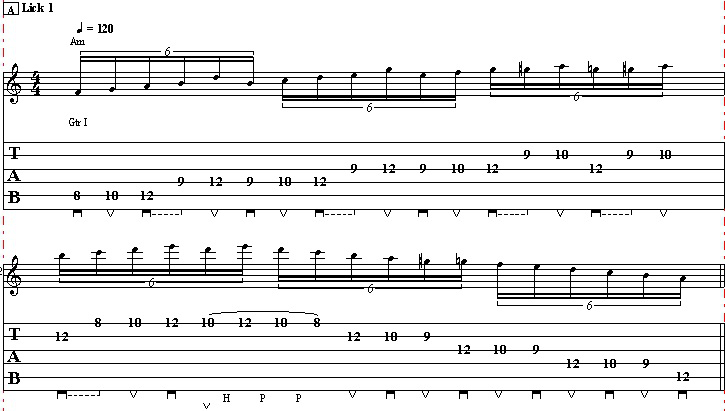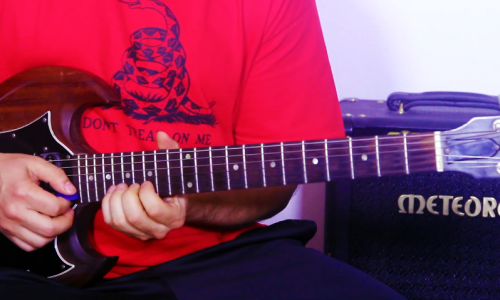Hey, how’s it going this is Sean Daniel with Guitar Control, today we’re learning the Classic time after time not really the Cyndi Lauper version but more of an Eva Cassidy version which if you haven’t heard it’s one of the greatest covers ever but this is going to be kind of faithful to both.
Click on the Tabs button to follow chords and tabs.
We kind of have a riff that were going to spend the verses and then a couple chord progressions it’s going to be like a pre-chorus and a chorus and basically it’s going to sound like this. So those are all three parts and again so the verse is going to sound like this, specifically it’s like a really beautiful kind of fun picking exercise almost in and of itself so again this is more taken from the Eva Cassidy version but it fits over the Cyndi Lauper version.
What we’re going to do is we’re going to start from your middle finger on the D-string and hammer-on to the 3rd fret on the D-string with your ring finger, so take it once and hammer-on and then we have the rest of this count. So if you make an A minor 7 shape like this with your middle finger on the 2nd fret of the D-string and your pointer finger on the 1st fret of the B-string that’s going to be kind of the home base of this whole thing, so what we’re going to do is inflect that 1st note then we’re going to hit the G- string and then the B-string afterwards so it’s like a three pick move but with one hammer-on.
So hammer G back to where you started it and the same thing just G, B, or D, G, B, D, G, B, so it’s kind of like 2- 3 counts 1, 2, 3, 1, 2, 3, 1, 2. So the last two counts of this total is eight count thing is really just going to be A open, D open G so 1, 2, 3, 1, 2, 3, 1, 2, 1, 2, 3, 1, 2, 3, it’s still eight count or one and two and three and four but we’re dynamically is the right word more accenting the 1st three, the 2nd, three, and then the last two counts. So this is going to come really handy with strumming patterns too but again I just wanted to go over that 1st lick and you can kind of experiment with in this too something like that as long as you stay in that count all I did there at the end is just go backwards from that chord G to D open whatever yeah there’s different ways you can kind of like play around with it it’s really more about just taking a verse and seeing what’s happening and then just playing something that you think sounds really good again really pretty kind of intro and really a good picking exercise to now that’s way faster than you need to play it but it just kind of gives you an idea of the count 1, 2, 3, 1, 2, 3, 1, 2, 1, 2, 3, 1, 2, 3, 1, 2, that’s going to take us to the pre-chorus and the chord progression is going to be it G, E minor, now you’ll notice that I’m not playing a barre chord, I definitely played if you want I just kind of want to make it a little bit easier where it’s just the middle four strings of that F major bar chord ring finger 3rd fret on the A-string and you 3rd from the D-string middle finger 2nd fret on the G-string pull your finger 1st D fret of the B-string, so instead of a half bar chord it’s just the middle and if you get the open high E-string no big deal this makes it that much prettier making it an F major seven chord so again here’s a half you can move that 2 frets higher to get a G chord or you can play an open G chord whichever you know any G chord is going to get the job done but I kind of like keeping this shape and I’ll show you why we’re going to go to the next court again so the chord progression is back to G to E minor to half okay so if you keep this one shape this middle 4 string shape here you go to the F to the G and then I’m going to slide it all the way keep the shape intact but now I’m just grabbing that minor chord with my ring finger and my pinky and then right back to half.
So I never have to get out as one shape this is kind of like an efficient way to do it A minor, B minor, G and then we can go back to the verse after this part depending on which part of the song you’re in this why it’s good to kind of follow along with the chord chart for sure and then we have the chorus part.
Now let’s go to a different form G major chord 3rd fret of the low E-string 2nd fret A-string high to A minor so this is the chorus of the entire line they’re really the money shot well no matter who’s singing it it’s amazing great song time after time it’s your right in the fields okay and all idea this is a good example of maybe using different chord voicing contextual and what’s happening that’s really the main reason to learn different chord voicing like I said we use this G major chord voicing just because we’re already in this app and it’s easy to get to the E minor and you can play the whole thing just like that again the 2nd part of that then we stay on an E minor, G minor. Again this is a good example of kind of the dichotomy between these two progressions in the same song.
So now the chord progression of the chorus is G major to A minor and then see all right so again the strumming is going to be interesting because if we have like G I’m just kind of keeping a steady pattern and then when I get to the app to the G I’m still kind of doing something that’s like that first million though 1, 2, 3, 1, 2, 3, 1, 2, 3, 1, 2, 3, 1, 2, 3, 1, 2, okay so let’s break down exactly is happening that course right we have one full count of again when I say one full bar of account I’m still thinking 1, 2, 3, 1, 2, 3, 1, 2, we can count it as a 4 count 1 & 2 & 3 & 4 & but I think getting the 1, 2, 3, 1, 2, 3, 1, 2, having an 8 count in that bar kind of gets the strumming pattern to make a little bit more sense kind of fits it in a little better, so 1 you do all down strokes like that I think it sounds a little bit better when you vary a little bit one two and three one two and three one so again whenever I see the word an that’s going to be an upstroke one every Bunch everyone’s a miner full bar there and then we have that
Now again this is where I kind of keep that same shape going from an F to a G whatever is easier for you go for it but this is just kind of like an example like I said because this shape a few G and then when you still say it’s a in that shape we can move it to a C major chord or your ring finger is on the low E-string your pinky is on 3rd fret of the A-string your middle fingers in the 2nd for the D-string your pointer fingers on the B-string, so same kind of strength better that F and that G gets split if we think of it as that eight count the first 3 are on the 8th the next five of the G and then I’m going to play all three parts interrupts we have the intro and again depending on what part of the song you’re in.
We go to the D minor, G, E-minor twice and then we go to the chorus A minor back to A minor so we really have three parts of a song that I really kind of really seamlessly blends together great song I definitely think anybody could benefit from learning it because it has a lot of cool different things along with like picking exercise it has different chord voicing you may not have used for the G chord before and kind of seeing how they work contextually together and this is like I said pulls it the old heartstrings so definitely make sure to click the link below to grab the chord chart for this and then definitely let us know in the comment section what you think what you’d like to see more of and then also check around the guitar control channel for other videos by myself a lot of other great instructions we teach a ton of different songs so if there’s anything that we haven’t done yet after you take a look let us know what it is and we’ll get right on.
Make sure to subscribe on our You Tube Channel and we’ll see you in our next video lessons, thanks for watching.
[ninja-popup ID=715]




